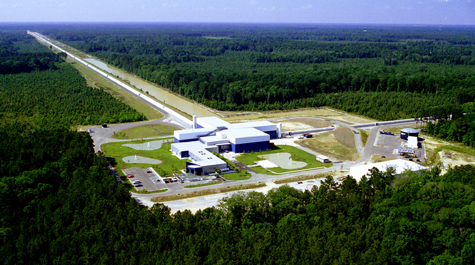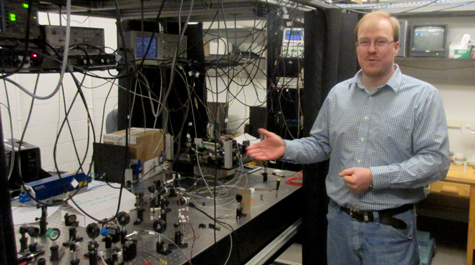LIGO-Virgo collaboration announces three-detector observation of gravitational waves
A scientific collaboration that includes physicists from William & Mary announced that three detectors on two continents recorded gravitational wave signals from a pair of black holes colliding.
It’s the first observation of gravitational waves by three different detectors, an event that a Sept. 27 press release from the National Science Foundation says marks “a new era of greater insights and improved localization of cosmic events now available through globally networked gravitational-wave observatories.”
Eugeniy Mikhailov, an assistant professor in William & Mary’s Department of Physics, is a member of the LIGO Scientific Collaboration (LSC), as is Mi Zhang, who received a Ph.D. in physics in 2017. They are coauthors on a paper documenting the three-detector collision, an event that occurred almost two billion years ago and recorded by two U.S.-based detectors as well as the Virgo detector in Italy.
To understand the value the Virgo detector adds, Mikhailov suggests imagining having a third ear. Two ears are better than one, he explained, and our brain naturally parses the information coming from both ears to localize the sound.
“If you have a third ear, which we as humans don’t have any experience with, you could locate a sound more precisely,” he said. “With a third detector, we can pinpoint exactly where the signal is coming from. There are three planes, x, y, z, and the third detector gives you the necessary third measurement. It changes the game completely.”
Mikhaliov and Zhang also were among the William & Mary scientists involved in a Sept. 14, 2015, LIGO detection, an event that was the first observation of gravitational waves.
This year’s collision, referred to as GW170814, was observed on Aug. 14 by the two National Science Foundation (NSF)-funded Laser Interferometer Gravitational-Wave Observatory (LIGO) detectors located in Livingston, Louisiana, and Hanford, Washington, and the Virgo detector, funded by a Franco-Italian consortium and located near Pisa, Italy.
The event represents the first confirmed gravitational wave signal recorded by the Virgo detector. A paper about the event, a collision designated GW170814, has been accepted for publication in the journal Physical Review Letters.
"Little more than a year and a half ago, NSF announced that its Laser Interferometer Gravitational Wave Observatory had made the first-ever detection of gravitational waves, which resulted from the collision of two black holes in a galaxy a billion light-years away," said NSF Director France Córdova in a Sept. 27 webcast announcement.
"Today, we are delighted to announce the first discovery made in partnership between the Virgo gravitational-wave observatory and the LIGO Scientific Collaboration, the first time a gravitational wave detection was observed by these observatories, located thousands of miles apart,” she continued. “This is an exciting milestone in the growing international scientific effort to unlock the extraordinary mysteries of our universe."
The detected gravitational waves — ripples in space and time predicted by Albert Einstein — were emitted during the final moments of the merger of two black holes, one with a mass about 31 times that of our sun, the other about 25 times the mass of the sun. The event, located about 1.8 billion light-years away resulted in a spinning black hole with about 53 times the mass of our sun.
"This is just the beginning of observations with the network enabled by Virgo and LIGO working together," said LSC spokesperson David Shoemaker of the Massachusetts Institute of Technology. "With the next observing run planned for fall 2018, we can expect such detections weekly or even more often."
The NSF release explained the importance of the additional detector: When an event is detected by a three-detector network, the area in the sky likely to contain the source shrinks significantly, improving distance accuracy. The sky region for GW170814 has a size of only 60 square degrees, more than 10 times smaller than the size using data available from the two LIGO interferometers alone.
"Being able to identify a smaller search region is important, because many compact object mergers — for example those involving neutron stars — are expected to produce broadband electromagnetic emissions in addition to gravitational waves," explained Georgia Tech's Laura Cadonati, deputy spokesperson for the LIGO Scientific Collaboration. "This precision pointing information enabled 25 partner facilities to perform follow-up observations based on the LIGO-Virgo detection, but no counterpart was identified — as expected for black holes."
"With this first joint detection by the Advanced LIGO and Virgo detectors, we have taken one step further into the gravitational-wave cosmos," said Caltech's David H. Reitze, executive director of the LIGO Laboratory. "Virgo brings a powerful new capability to detect and better locate gravitational-wave sources, one that will undoubtedly lead to exciting and unanticipated results in the future." Skip to main content
Skip to main content


